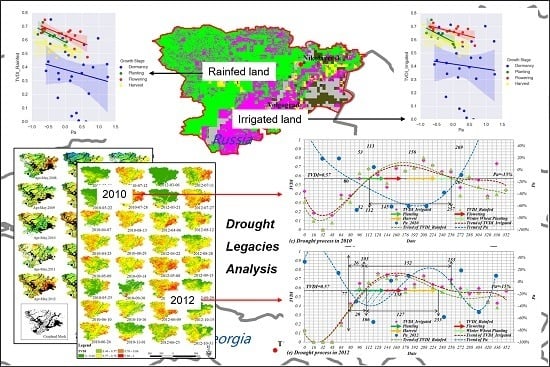Different Drought Legacies of Rain-Fed and Irrigated Croplands in a Typical Russian Agricultural Region
Abstract
1. Introduction
2. Materials and Methods
2.1. Study Area
2.2. Satellite Imagery and Auxiliary Data
2.3. Temperature Vegetation Drought Index (TVDI)
2.4. Percentage of Precipitation Anomaly (Pa)
2.5. Comprehensive Drought Disaster Index (CDDI)
3. Results
3.1. Time Evolution of TVDI Drought Monitoring
- (1)
- Planting stage from April to May: An extreme lack of rain in early April 2010 led to a reduction of the soil water content, which restrained root water absorption and the water supply for leaf growth. This agrometeorological propagation exerted a considerable influence on the heading process of winter wheat, which is widely distributed in the rain-fed drylands to the north of the river. The same process took place in May 2012, during which a precipitation deficit and rapidly rising temperature caused extensive stress to regional crops;
- (2)
- Flowering stage from June to early August: The cumulative precipitation in June and July 2010 was only about 30% of the level in the same period, accompanied by extremely high temperatures in July. Intense soil evaporation led to the soil moisture restraining the biophysical process of crops during flowering. The relative water content of the leaves rapidly decreased under high temperature stress, which led to an imbalance between the water supply and demand and consequently, spreading drought. Crops also suffered from water deficit when rainfall was not absent in 2012. On account of intense solar radiation and an extremely high temperature in June, the potential atmospheric evaporation was quite strong, leading to vigorous crop transpiration. The water absorbed by the root system from the upper soil was inadequate to compensate for transpiration consumption, thus resulting in water deficit in the flowering stage of corn, dominantly cultivated in southern irrigated land;
- (3)
- Harvest stage from late July through to the end of October: The gradual rain rebound and the arrival of a cool harvest autumn restored the soil moisture and alleviated the summer drought. Crops require different levels of water during their various growth stages, and the water demand is greatest in the early and middle stages of growth. In general, the TVDI drought monitoring results in Figure 6 show different phenomena for the various months. The drought in 2010 primarily occurred in early April and from June to August, and was affected by the simultaneous impacts of high temperatures and low rainfall. The drought in 2012 mainly occurred from April to June and was mostly affected by the lack of precipitation.
3.2. Factor Analysis of Drought Conditions between Rain-Fed and Irrigated Lands
- (1)
- Duration: Irrigated land suffered earlier than rain-fed land in terms of their starting times and durations. Additionally, the degree of drought for the irrigated land was higher than that for the rain-fed land within the considered years, except for 2010. The rain-fed land drought always ended earlier due to its sensitivity to water and heat conditions;
- (2)
- Climatic factors: The distinction in the drought intensity between the rain-fed and irrigated lands is influenced by disturbances in the average surface temperature and extreme weather events. Figure 7 shows the monthly mean temperature changes for the two types of cultivated lands over the same period. It can be seen that the irrigated land is located in the southeastern region of Volgograd with lower latitudes and is closer to the steppe semi-desert zone in the northern Caspian Sea. Therefore, its average monthly temperature is higher than that of the rain-fed arable land in the northwest for most of the year. Considering this, the local climate sensitivity factors include a higher average surface temperature (), extremely low rainfall (2010 and 2012), and exceptionally high temperatures (2010) [71];
- (3)
- Sensitivity: Irrigated land is more sensitive to disturbances in the precipitation factor as dominated by the average surface temperature, while the rain-fed land is more sensitive to disturbances in the temperature factor as dominated by the precipitation. This also explains the greater effects of a drought on irrigated land, which appears earlier and lasts longer. Moreover, this also provides a reason for the higher sensitivity of rain-fed land to droughts when extreme high-temperature events occurred in 2010, but the stronger regulation capacity of irrigated land.
3.3. Lagging Relationship between Meteorological and Agricultural Droughts
3.3.1. Hysteresis at Different Growth Stages between Pa and TVDI
3.3.2. Forecasting Ability of the Meteorological Drought Index Pa
3.4. Analysis of Drought Disasters
4. Discussion
4.1. Single Index Selection and Data Limitation
4.2. Gradually Strengthen Lag Analysis
4.3. Supplement and Refinement of Spatial Factors
5. Conclusions
5.1. Identification of Drought Events in 2010 and 2012
5.2. Difference in Droughts between Rain-Fed and Irrigation Lands and the Influencing Factors
5.3. Lag Analysis of Meteorological and Agricultural Droughts
5.4. Regional Drought Risk and Irrigation Guidance
Author Contributions
Funding
Acknowledgments
Conflicts of Interest
References
- Huschke, R.E. Glossary of Meteorology; American Meteorological Society: Boston, MA, USA, 1959. [Google Scholar]
- Richard, R.; Heim, J.R. A review of twentieth-century drought indices used in the United States. Bull. Am. Meteorol. Soc. 2002. [Google Scholar] [CrossRef]
- Intergovernmental Panel on Climate Change. Climate Change 2014: Synthesis Report. Contribution of Working Groups I, II and III to the Fifth Assessment Report of the Intergovernmental Panel on Climate Change; IPCC: Geneva, Switzerland, 2014; p. 151. [Google Scholar]
- Intergovernmental Panel on Climate Change. Managing the Risk of Extreme Event and Disasters to Advance Climate Change Adaptation-Special Report of the Intergovernmental Panel on Climate Change; IPCC: Geneva, Switzerland, 2012. [Google Scholar]
- West, H.; Quinn, N.; Horswell, M. Remote sensing for drought monitoring & impact assessment: Progress, past challenges and future opportunities. Remote Sens. Environ. 2019, 232. [Google Scholar] [CrossRef]
- Wilhite, D.A.; Glantz, M.H. Understanding: The Drought Phenomenon: The Role of Definitions. Water Int. 1985, 10, 111–120. [Google Scholar] [CrossRef]
- Van, L.; Anne, F. Hydrological drought explained. Wiley Interdiscip. Rev. Water 2015, 2, 359–392. [Google Scholar] [CrossRef]
- Dracup, J.A.; Lee, K.S.; Paulson, E.G. On the Definition of Drought. Water Resour. Res. 1980, 16, 297–303. [Google Scholar] [CrossRef]
- Smakhtin, V.; Schipper, L. Droughts: The impact of semantics and perceptions. Water Policy 2008, 10. [Google Scholar] [CrossRef]
- Ray, D.K.; Mueller, N.D.; West, P.C.; Foley, J.A. Yield Trends Are Insufficient to Double Global Crop Production by 2050. PLoS ONE 2013, 8, e66428. [Google Scholar] [CrossRef]
- National Standards of People’s Republic of China. GB/T 20481-2017 Grades of Meteorological Drought; National Standards of People’s Republic of China: Beijing, China, 2017. [Google Scholar]
- Palmer, W.C. Meteorological Drought; U.S. Department of Commerce Weather Bureau: Washington, DC, USA, 1965; p. 58. [Google Scholar]
- McKee, T.; Doesken, N.; Kleist, J. The Relationship of Drought Frequency and Duration to Time Scales. In Proceedings of the 8th Conference on Applied Climatology, Anaheim, CA, USA, 17–22 January 1993; p. 17. [Google Scholar]
- Vicente-Serrano, S.; Beguería, S.; López-Moreno, J.I. A multi-scalar drought index sensitive to global warming: The Standardized Precipitation Evapotranspiration Index-SPEI. J. Clim. Appl. Meteorol. 2009, 23. [Google Scholar] [CrossRef]
- Yu, B.; Yang, L.; Chen, F. Semantic Segmentation for High Spatial Resolution Remote Sensing Images Based on Convolution Neural Network and Pyramid Pooling Module. IEEE J. Sel. Top. Appl. Earth Obs. Remote Sens. 2018, 11, 3252–3261. [Google Scholar] [CrossRef]
- Wang, N.; Chen, F.; Yu, B.; Qin, Y. Segmentation of large-scale remotely sensed images on a Spark platform: A strategy for handling massive image tiles with the MapReduce model. ISPRS 2020, 162, 137–147. [Google Scholar] [CrossRef]
- Chen, F.; Yu, B.; Li, B. A practical trial of landslide detection from single-temporal Landsat8 images using contour-based proposals and random forest: A case study of national Nepal. Landslides 2018, 15, 453–464. [Google Scholar] [CrossRef]
- Chen, F.; Zhang, M.; Tian, B.; Li, Z. Extraction of Glacial Lake Outlines in Tibet Plateau Using Landsat 8 Imagery and Google Earth Engine. IEEE J. Sel. Top. Appl. Earth Obs. Remote Sens. 2017, 10, 4002–4009. [Google Scholar] [CrossRef]
- Bondur, V.G. Satellite monitoring of wildfires during the anomalous heat wave of 2010 in Russia. Izv. Atmos. Ocean. Phys. 2012, 47, 1039–1048. [Google Scholar] [CrossRef]
- Bondur, V.; Gordo, K.; Kladov, V. Spacetime Distributions of Wildfire Areas and Emissions of Carbon-Containing Gases and Aerosols in Northern Eurasia according to Satellite-Monitoring Data. Izv. Atmos. Ocean. Phys. 2017, 53, 859–874. [Google Scholar] [CrossRef]
- Bondur, V.; Vorobev, V. Satellite monitoring of impact Arctic regions. Izv. Atmos. Ocean. Phys. 2015, 51, 949–968. [Google Scholar] [CrossRef]
- Lin, Z.; Chen, F.; Niu, Z.; Li, B.; Yu, B.; Jia, H.; Zhang, M. An active fire detection algorithm based on multi-temporal FengYun-3C VIRR data. Remote Sens. Environ. 2018, 211, 376–387. [Google Scholar] [CrossRef]
- Lin, Z.; Chen, F.; Li, B.; Yu, B.; Jia, H.; Zhang, M.; Liang, D. A Contextual and Multitemporal Active-Fire Detection Algorithm Based on FengYun-2G S-VISSR Data. IEEE Trans. Geosci. Remote Sens. 2019, 57, 8840–8852. [Google Scholar] [CrossRef]
- Price, J. Thermal Inertia Mapping: A New View of the Earth. J. Geophys. Res. 1977, 82. [Google Scholar] [CrossRef]
- Ghulam, A.; Qin, Q.; Zhan, Z. Designing of the perpendicular drought index. Environ. Geol. 2007, 52, 1045–1052. [Google Scholar] [CrossRef]
- Ghulam, A.; Qin, Q.; Teyip, T.; Li, Z.-L. Modified perpendicular drought index (MPDI): A real-time drought monitoring method. Isprs J. Photogramm. Remote Sens. 2007, 150–164. [Google Scholar] [CrossRef]
- Rao, M.; Silber-Coats, Z.; Powers, S.; Fox III, L.; Ghulam, A. Mapping drought-impacted vegetation stress in California using remote sensing. Gisci. Remote Sens. 2017, 54, 185–201. [Google Scholar] [CrossRef]
- Kogan, F.N. Application of vegetation index and brightness temperature for drought detection. Adv. Space Res. 1995, 15, 91–100. [Google Scholar] [CrossRef]
- Jackson, R.D.; Idso, S.; Reginato, R.J.; Pinter, P. Canopy Temperature as a Crop Water Stress Indicator. Water Resour. Res. 1981, 17. [Google Scholar] [CrossRef]
- Moran, M.S.; Clarke, T.R.; Inoue, Y.; Vidal, A. Estimating crop water deficit using the relation between surface-air temperature and spectral vegetation index. Remote Sens. Environ. 1994, 49, 246–263. [Google Scholar] [CrossRef]
- Sandholt, I.R.; Anderson, J. A simple interpretation of the surface temperature/vegetation index space for assessment of surface moisture status. Remote Sens. Environ. 2002, 79, 213–224. [Google Scholar] [CrossRef]
- Wenbin, Z.; Lv, A.; Jia, S.; Sun, L. Development and evaluation of the Modified Temperature-Vegetation Dryness Index (MTVDI) for soil moisture monitoring: Development and evaluation of mtvdi. J. Geophys. Res. Atmos. 2017. [Google Scholar] [CrossRef]
- Wenbin, Z.; Jia, S.; Lv, A. A time domain solution of the Modified Temperature Vegetation Dryness Index (MTVDI) for continuous soil moisture monitoring. Remote Sens. Environ. 2017, 200, 1–17. [Google Scholar] [CrossRef]
- Bayarjargal, Y.; Karnieli, A.; Bayasgalan, M.; Khudulmur, S.; Gandush, C.; Tucker, C.J. A comparative study of NOAA–AVHRR derived drought indices using change vector analysis. Remote Sens. Environ. 2006, 105, 9–22. [Google Scholar] [CrossRef]
- Haboudane, D.; Miller, J.R.; Pattey, E.; Zarco-Tejada, P.J.; Strachan, I.B. Hyperspectral vegetation indices and novel algorithms for predicting green LAI of crop canopies: Modeling and validation in the context of precision agriculture. Remote Sens. Environ. 2004, 90, 337–352. [Google Scholar] [CrossRef]
- Tucker, C.J. Red and photographic infrared linear combinations for monitoring vegetation. Remote Sens. Environ. 1979, 8, 127–150. [Google Scholar] [CrossRef]
- Kogan, F.; Sullivan, J. Development of global drought-watch system using NOAA/AVHRR data. Adv. Space Res. 1993, 13, 219–222. [Google Scholar] [CrossRef]
- Peters, A.W.-S. Drought monitoring with NDVI-based standardized vegetation index. Photogramm. Eng. Remote Sens. 2002, 68, 71–75. [Google Scholar]
- Anyamba, A.; Tucker, C. NDVI anomaly patterns over Africa during the 1997 /98 ENSO warm event. Int. J. Remote Sens. 2001, 22. [Google Scholar] [CrossRef]
- Huete, A.; Didan, K.; Miura, T.; Rodriguez, E.P.; Gao, X.; Ferreira, L.G. Overview of the radiometric and biophysical performance of the MODIS vegetation indices. Remote Sens. Environ. 2002, 83, 195–213. [Google Scholar] [CrossRef]
- Li, z.; Qin, Q.; Tong, Q.; Wang, J.; Zhu, L. A method for remote sensing of moisture in the canopy of fully covered vegetation: Short wave infrared perpendicular water stress index. Sci. China (Ser. D) 2007, 37, 957–965. [Google Scholar] [CrossRef]
- Ceccato, P.; Gobron, N.; Flasse, S.; Pinty, B.; Tarantola, S. Designing a spectral index to estimate vegetation water content from remote sensing data: Part 1: Theoretical approach. Remote Sens. Environ. 2002, 82, 188–197. [Google Scholar] [CrossRef]
- Zhang, A.; Jia, G. Monitoring meteorological drought in semiarid regions using multi-sensor microwave remote sensing data. Remote Sens. Environ. 2013, 134, 12–23. [Google Scholar] [CrossRef]
- Mao, K.; Gao, C.; Han, L.; Zhang, W.; Tang, H. The drought monitoring in China by using AMSR-E data. In Proceedings of the 2010 2nd IITA International Conference on Geoscience and Remote Sensing (IITA-GRS 2010), Qingdao, China, 28–31 August 2010; p. 1. [Google Scholar] [CrossRef]
- Liu, L.; Liao, J.; Chen, X.; Zhou, G.; Su, Y.; Xiang, Z.; Wang, Z.; Liu, X.; Li, Y.; Wu, J.; et al. The Microwave Temperature Vegetation Drought Index (MTVDI) based on AMSR-E brightness temperatures for long-term drought assessment across China (2003–2010). Remote Sens. Environ. 2017, 199, 302–320. [Google Scholar] [CrossRef]
- Bayissa, Y.A.; Tadesse, T.; Svoboda, M.; Wardlow, B.; Poulsen, C.; Swigart, J.; Van Andel, S.J. Developing a satellite-based combined drought indicator to monitor agricultural drought: A case study for Ethiopia. Gisci. Sens. Environ. 2019, 56, 718–748. [Google Scholar] [CrossRef]
- Vyas, S.S.; Bhattacharya, B.K.; Nigam, R.; Guhathakurta, P.; Ghosh, K.; Chattopadhyay, N.; Gairola, R.M. A combined deficit index for regional agricultural drought assessment over semi-arid tract of India using geostationary meteorological satellite data. Int. J. Appl. Earth Obs. Geoinf. 2015, 39, 28–39. [Google Scholar] [CrossRef]
- Zuo, D.; Cai, S.; Xu, Z.; Peng, D.; Kan, G.; Sun, W.; Pang, B.; Yang, H. Assessment of meteorological and agricultural droughts using in-situ observations and remote sensing data. Agric. Water Manag. 2019, 222, 125–138. [Google Scholar] [CrossRef]
- Rhee, J.; Im, J.; Carbone, G.J. Monitoring agricultural drought for arid and humid regions using multi-sensor remote sensing data. Remote Sens. Environ. 2010, 114, 2875–2887. [Google Scholar] [CrossRef]
- Du, L.; Tian, Q.; Yu, T.; Meng, Q.; Jancso, T.; Udvardy, P.; Huang, Y. A comprehensive drought monitoring method integrating MODIS and TRMM data. Int. J. Appl. Earth Obs. Geoinf. 2013, 23, 245–253. [Google Scholar] [CrossRef]
- Hao, C.; Zhang, J.; Yao, F. Combination of multi-sensor remote sensing data for drought monitoring over Southwest China. Int. J. Appl. Earth Obs. Geoinf. 2015, 35, 270–283. [Google Scholar] [CrossRef]
- Gao, B.-C. NDWI—A normalized difference water index for remote sensing of vegetation liquid water from space. Remote Sens. Environ. 1996, 58, 257–266. [Google Scholar] [CrossRef]
- Ezzine, H.; Bouziane, A.; Ouazar, D. Seasonal comparisons of meteorological and agricultural drought indices in Morocco using open short time-series data. Int. J. Appl. Earth Obs. Geoinf. 2014, 26, 36–48. [Google Scholar] [CrossRef]
- Gu, Y.X.; Brown, J.F.; Verdin, J.P.; Wardlow, B. A five-year analysis of MODIS NDVI and NDWI for grassland drought assessment over the central Great Plains of the United States. Geophys. Res. Lett. 2007, 34. [Google Scholar] [CrossRef]
- Son, N.T.; Chen, C.F.; Chen, C.R.; Chang, L.Y.; Minh, V.Q. Monitoring agricultural drought in the Lower Mekong Basin using MODIS NDVI and land surface temperature data. Int. J. Appl. Earth Obs. Geoinf. 2012, 18, 417–427. [Google Scholar] [CrossRef]
- Chen, B.-Y.; Yang, L.; Chen, X.; Wang, W.-S. Application Resaerch Based on Modified TVDI in Drought Monitoring in Arid Areas. Arid Land Geogr. 2019, 42, 902–913. [Google Scholar]
- Du, B.; Alatengtuya; Bao, G. Temporal and Spatial Characteristics of Drought in the Xilingol Grassland From 2002 to 2016. Res. Soil Water Conserv. 2019, 26, 190–202. [Google Scholar] [CrossRef]
- Liang, L.; Zhao, S.-H.; Qin, Z.-H.; He, K.-X.; Chen, C.; Luo, Y.-X.; Zhou, X.-D. Drought Change Trend Using MODIS TVDI and Its Relationship with Climate Factors in China from 2001 to 2010. J. Integr. Agric. 2014, 13, 1501–1508. [Google Scholar] [CrossRef]
- Wu, X.; Na, X.; Zang, S. Application of temperature vegetation dryness index in the estimation of soil moisture of the Songnen Plain. Acta Ecol. Sin. 2019, 39, 4432–4441. [Google Scholar]
- Savin, I.Y.; Stolbovoy, V.S.; Savitskaya, N.V. Climatic potential for winter wheat yield in Russia. Russ. Agric. Sci. 2017, 43, 296–299. [Google Scholar] [CrossRef]
- Ukhova, D. The 2012 Drought, Russian Farmers, and the Challenges of Adapting to Extreme Weather Event; OXFAM: Oxford, UK, 2013. [Google Scholar]
- Wegren, S.K. Food Security and Russia’s 2010 Drought. Eurasian Geogr. Econ. 2013, 52, 140–156. [Google Scholar] [CrossRef]
- Bondur, V.G. Aerospace methods and technologies for monitoring oil and gas areas and facilities. Izv. Atmos. Ocean. Phys. 2012, 47, 1007–1018. [Google Scholar] [CrossRef]
- Bondur, V.; Tsidilina, M.; Cherepanova, E. Satellite monitoring of wildfire impacts on the conditions of various types of vegetation cover in the federal districts of the Russian Federation. Исследoвания Земли Кoсмoса 2019, 13–32. [Google Scholar] [CrossRef]
- Bondur, V.; Tsidilina, M.; Kladov, V.; Gordo, K. Irregular variability of spatiotemporal distributions of wildfires and emissions of harmful trace gases in Europe based on satellite monitoring data. Дoклады Акаде 2019, 485, 745–749. [Google Scholar] [CrossRef]
- Bondur, V.; Vorobyev, V.; Lukin, A. Satellite Monitoring of the Northern Territories Disturbed by Oil Production. Izv. Atmos. Ocean. Phys. 2017, 53, 1007–1015. [Google Scholar] [CrossRef]
- Bondur, V.G.; Gordo, K.A. Satellite Monitoring of Burnt-out Areas and Emissions of Harmful Contaminants Due to Forest and Other Wildfires in Russia. Izv. Atmos. Ocean. Phys. 2018. [Google Scholar] [CrossRef]
- Bondur, V.; Ginzburg, A. Emission of carbon-bearing gases and aerosols from natural fires on the territory of Russia based on space monitoring. Dokl. Earth Sci. 2016, 466, 148–152. [Google Scholar] [CrossRef]
- Bondur, V. Satellite monitoring of trace gas and aerosol emissions during wildfires in Russia. Izv. Atmos. Ocean. Phys. 2016, 52, 1078–1091. [Google Scholar] [CrossRef]
- Safonov, G.; Safonova, Y. Economic Analysis of the Impact of Climate Change in Agriculture in Russia; Oxfam International: Oxford, UK, 2013. [Google Scholar]
- Blunden, J.; Arndt, D.S.; Baringer, M.O. State of the Climate in 2010. Bull. Am. Meteorol. Soc. 2011, 92, S1–S236. [Google Scholar] [CrossRef]
- Cherenkova, E.; Kononova, N.; Muratova, N. Summer Drought 2010 in the European Russia. Geogr. Environ. Sustain. 2013, 6. [Google Scholar] [CrossRef]
- Weatherbase. VOLGOGRAD, RUSSIA. Available online: http://www.weatherbase.com/weather/weather-summary.php3?s=592102&cityname=Volgograd%2C+Volgograd%2C+Russia&units= (accessed on 26 May 2020).
- Teluguntla, P.; Thenkabail, P.S.; Xiong, J.; Gumma, M.K.; Giri, C.; Milesi, C.; Ozdogan, M.; Congalton, R.G.; Tilton, J.; Sankey, T.T.; et al. Remote Sensing Handbook:Land Resources: Monitoring, Modelling, and Mapping; Thenkabail, P.S., Ed.; Taylor & Francis: Abingdon, UK, 2012; Volume 2. [Google Scholar]
- IPAD. Crop Calendars for Russia Federation (Russia, Azerbaijan, Armenia and Georgia). International Production Assessment Division; District, R.S., Ed.; United States Department of Agriculture, Foreign Agricultural Service: Washington, DC, USA, 2019. [Google Scholar]
- IPAD. Monthly Crop. Stage Calendars. International Production Assessment Division; United States Department of Agriculture, Foreign Agricultural Service: Washington, DC, USA, 2019. [Google Scholar]
- Sorooshian, S.H.; Kuolin; Braithwaite, D.; Ashouri, H.; NOAA CDR Program. NOAA Climate Data Record (CDR) of Precipitation Estimation from Remotely Sensed Information using Artificial Neural Networks (PERSIANN-CDR); NOAA National Centers for Environmental Information: Asheville, NC, USA, 2014. [Google Scholar] [CrossRef]
- Ashouri, H.; Hsu, K.; Sorooshian, S.; Braithwaite, D.; Knapp, K.; Cecil, L.; Nelson, B.; Prat, O. PERSIANN-CDR: Daily Precipitation Climate Data Record from Multisatellite Observations for Hydrological and Climate Studies. Bull. Am. Meteorol. Soc. 2014, 96. [Google Scholar] [CrossRef]
- Chen, J.; Chen, J.; Liao, A.; Cao, X.; Chen, L.; Chen, X.; He, C.; Han, G.; Peng, S.; Lu, M.; et al. Global land cover mapping at 30m resolution: A POK-based operational approach. Isprs J. Photogramm. Remote Sens. 2015, 103, 7–27. [Google Scholar] [CrossRef]
- Chen, J.; Liao, A.; Chen, J.; Peng, S.; Chen, L.; Zhang, H. 30-Meter Global Land Cover Data Product-Globe Land30. Geomat. World 2017, 24, 1–8. [Google Scholar]
- Jun, C.; Ban, Y.; Li, S. Open access to Earth land-cover map. Nature 2014, 514, 434. [Google Scholar] [CrossRef]
- Wu, L. Classification of Drought Grades Based on Temperature Vegetation Drought Index Using the MODIS Data. Res. Soil Water Conserv. 2017, 24, 130–135. [Google Scholar] [CrossRef]
- Dhakar, R.; Sehgal, V.K.; Pradhan, S. Study on inter-seasonal and intra-seasonal relationships of meteorological and agricultural drought indices in the Rajasthan State of India. J. Arid Environ. 2013, 97, 108–119. [Google Scholar] [CrossRef]
- Doi, R. Vegetational response of rainfall in Rajasthan using AVHRR imagery. J. Indian Soc. Remote Sens. 2001, 29, 213–224. [Google Scholar] [CrossRef]
- Wang, J.; Price, K.; Rich, P. Spatial patterns of NDVI in response to precipitation and temperature in the Central Great Plains. Int. J. Remote Sens. 2001, 22, 3827–3844. [Google Scholar] [CrossRef]
- Wang, J.; Rich, P.M.; Price, K.P. Temporal responses of NDVI to precipitation and temperature in the central Great Plains, USA. Int. J. Remote Sens. 2003, 24, 2345–2364. [Google Scholar] [CrossRef]
- Gong, D.; Hao, M.; Hou, Q. Study on the Complex Index of the Drought Disaster. Meteorol. Mon. 1996, 22, 3–7. [Google Scholar] [CrossRef]
- Ozelkan, E.; Chen, G.; Üstündağ, B. Multiscale object-based drought monitoring and comparison in rainfed and irrigated agriculture from Landsat 8 OLI imagery. Int. J. Appl. Earth Obs. Geoinf. 2016, 44, 159–170. [Google Scholar] [CrossRef]
- Peña-Gallardo, M.; Vicente-Serrano, S.M.; Domínguez-Castro, F.; Beguería, S. The impact of drought on the productivity of two rainfed crops in Spain. Nat. Hazards Earth Syst. Sci. 2019, 19, 1215–1234. [Google Scholar] [CrossRef]
- Huang, S.; Huang, Q.; Chang, J.; Leng, G.; Xing, L. The response of agricultural drought to meteorological drought and the influencing factors: A case study in the Wei River Basin, China. Agric. Water Manag. 2015, 159, 45–54. [Google Scholar] [CrossRef]
- Mamnouie, R.E.; Ghazvini, F.; Esfahany, M.; Nakhoda, B. The Effects of Water Deficit on Crop Yield and the Physiological Characteristics of Barley (Hordeum vulgare L.) Varieties. J. Agric. Sci. Technol. 2006, 8, 211–219. [Google Scholar]
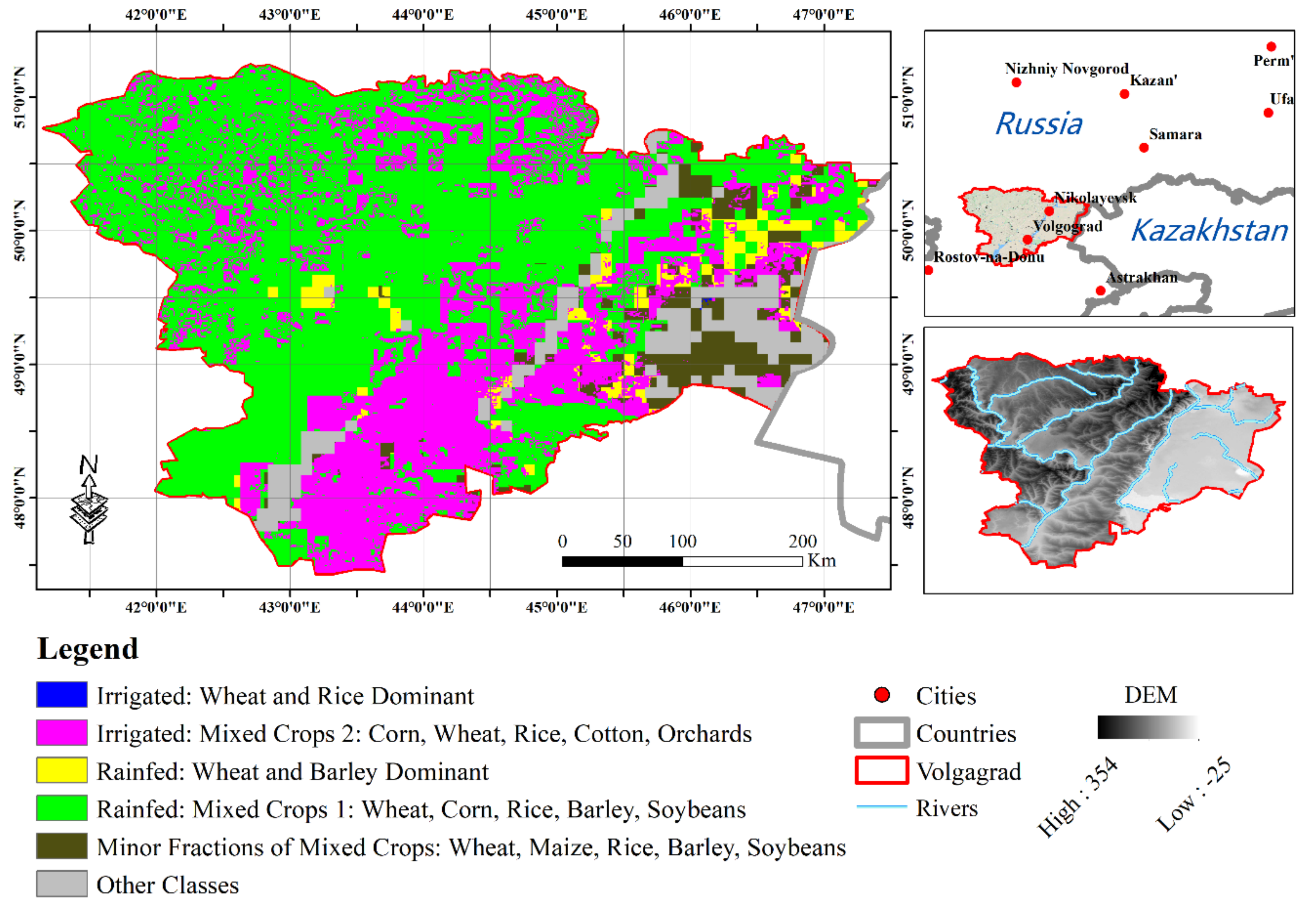





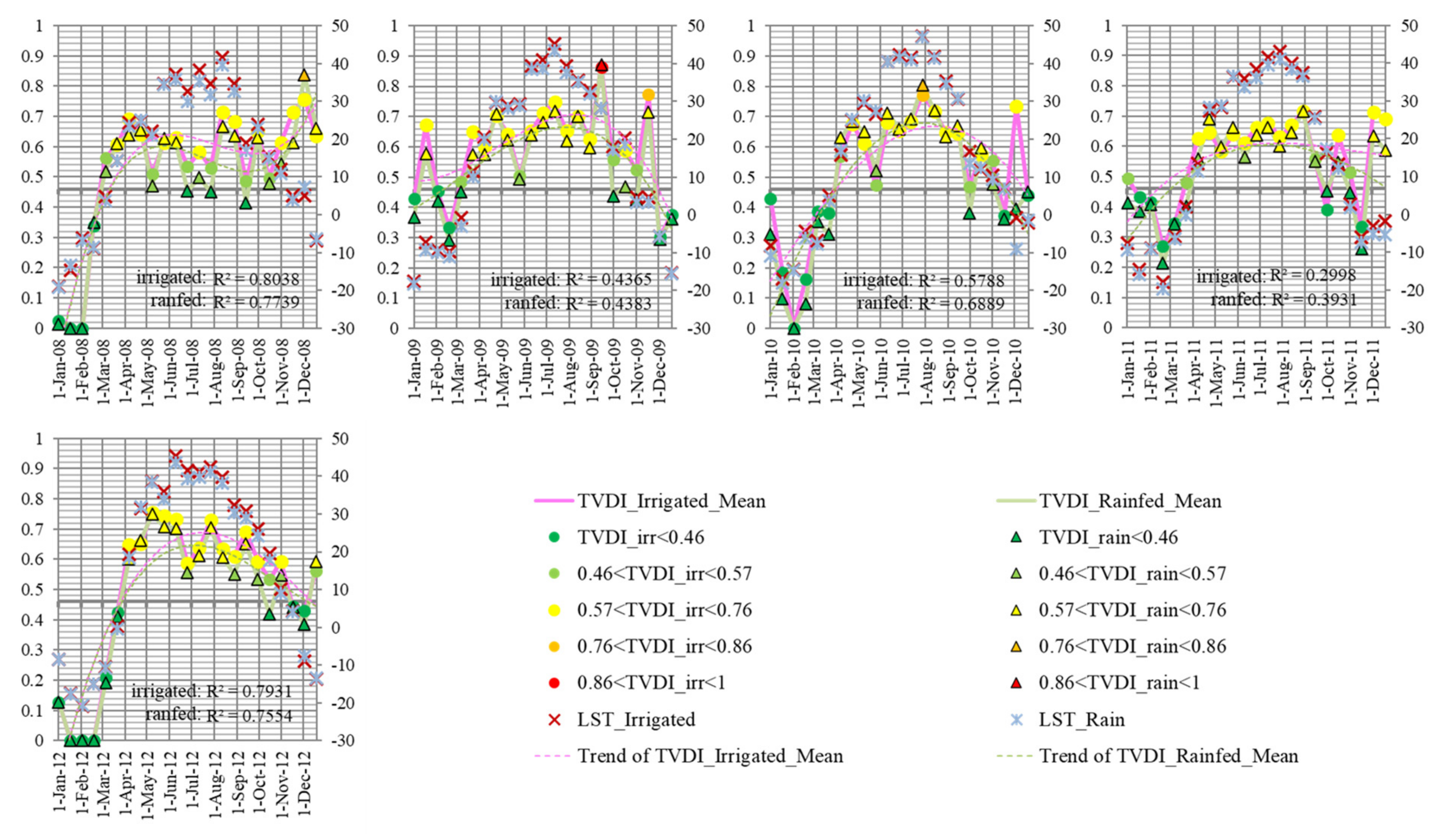
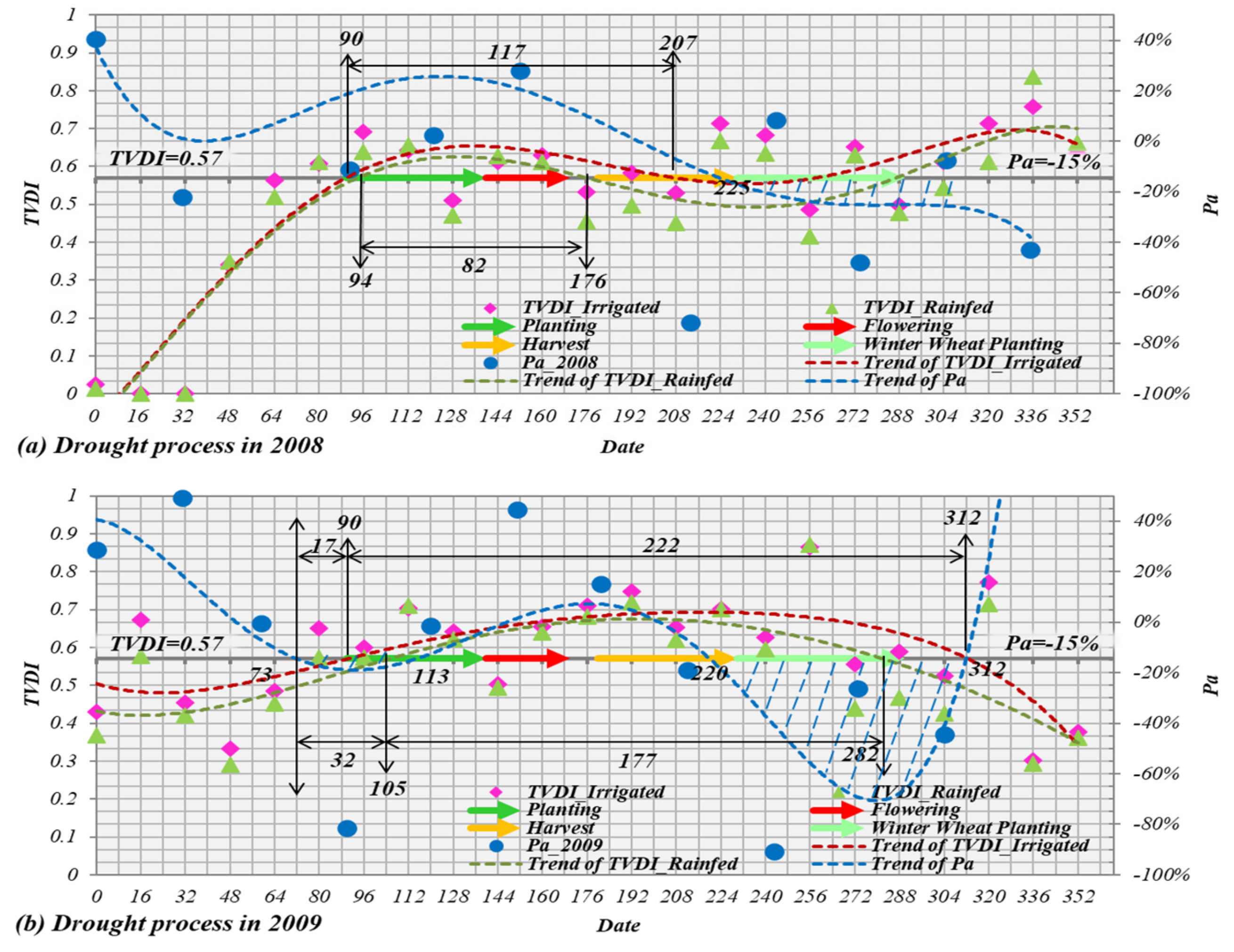
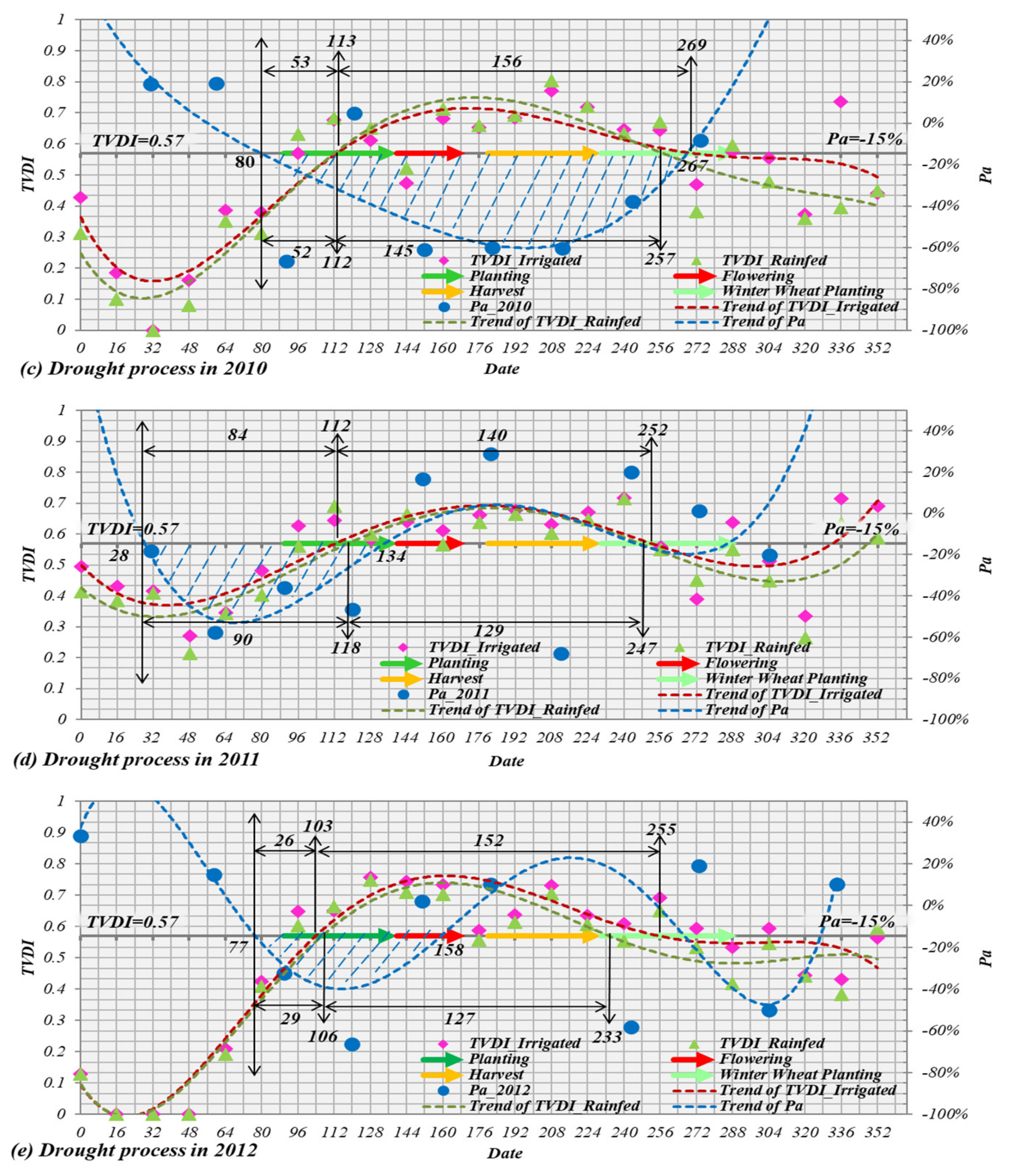
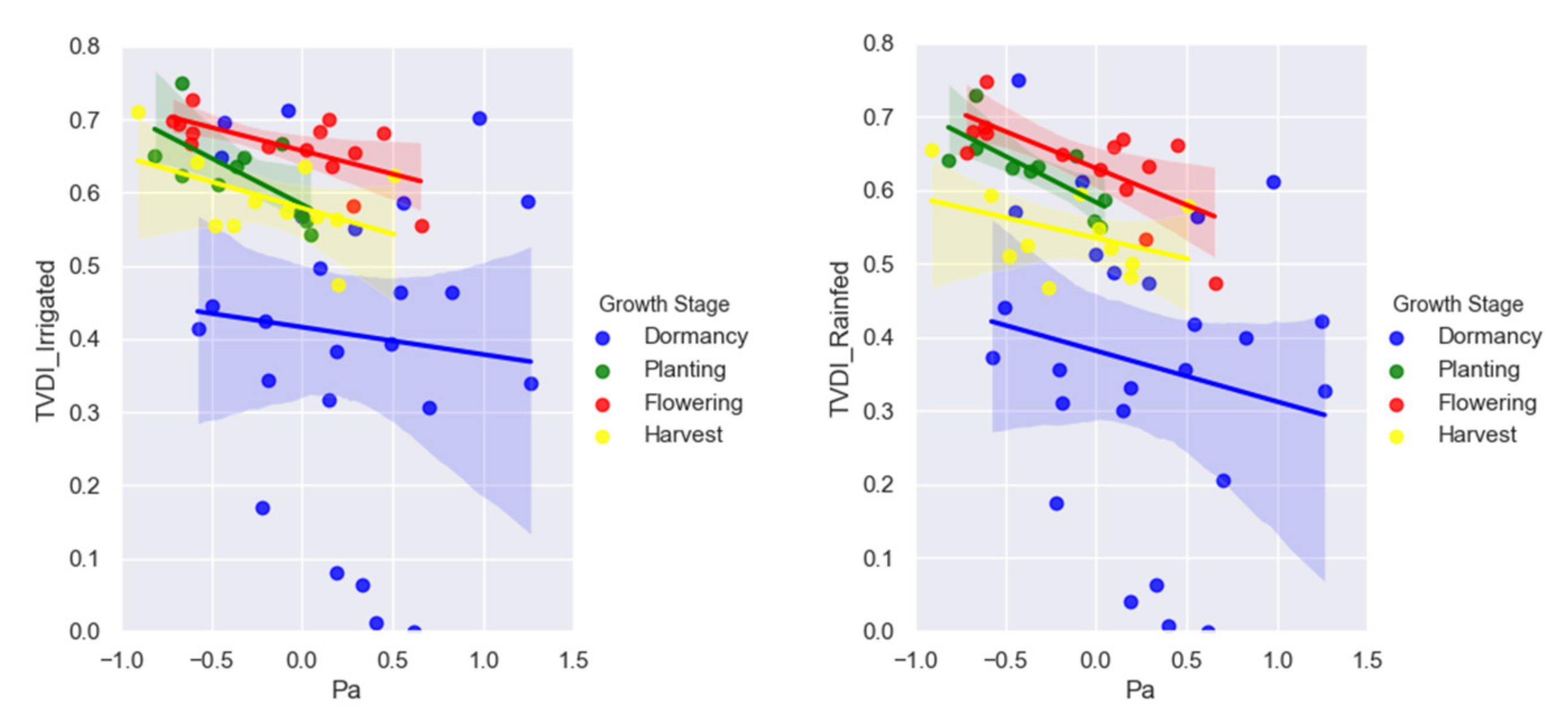
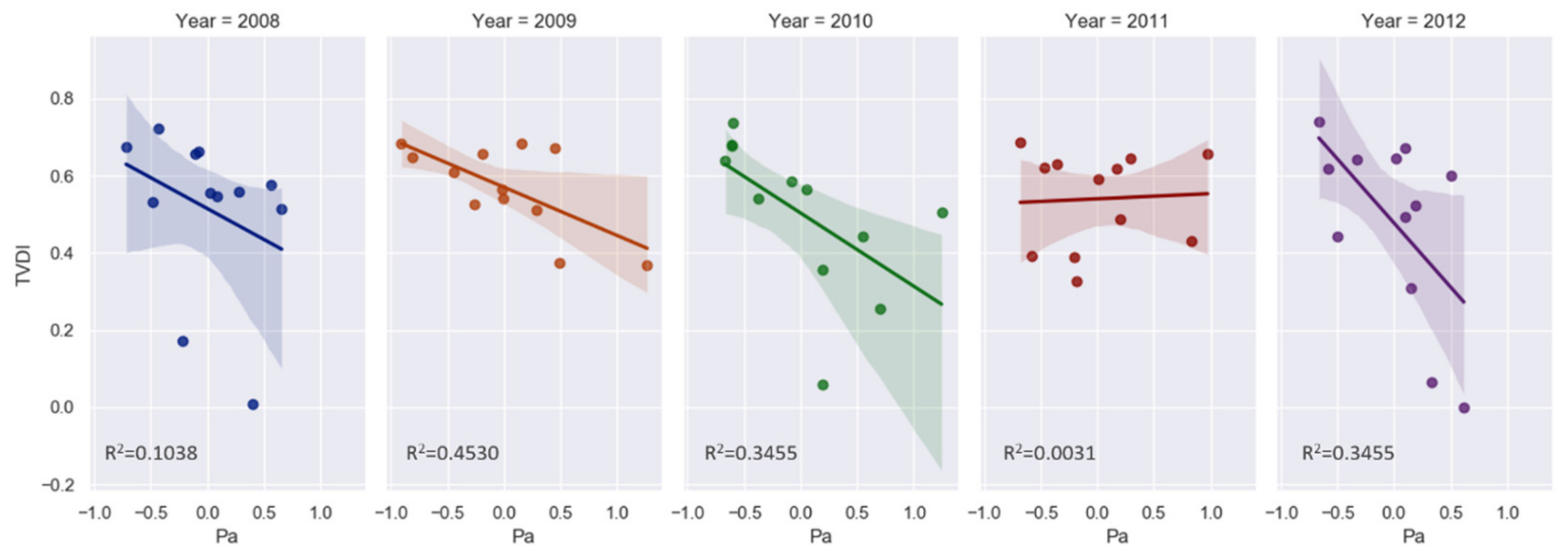
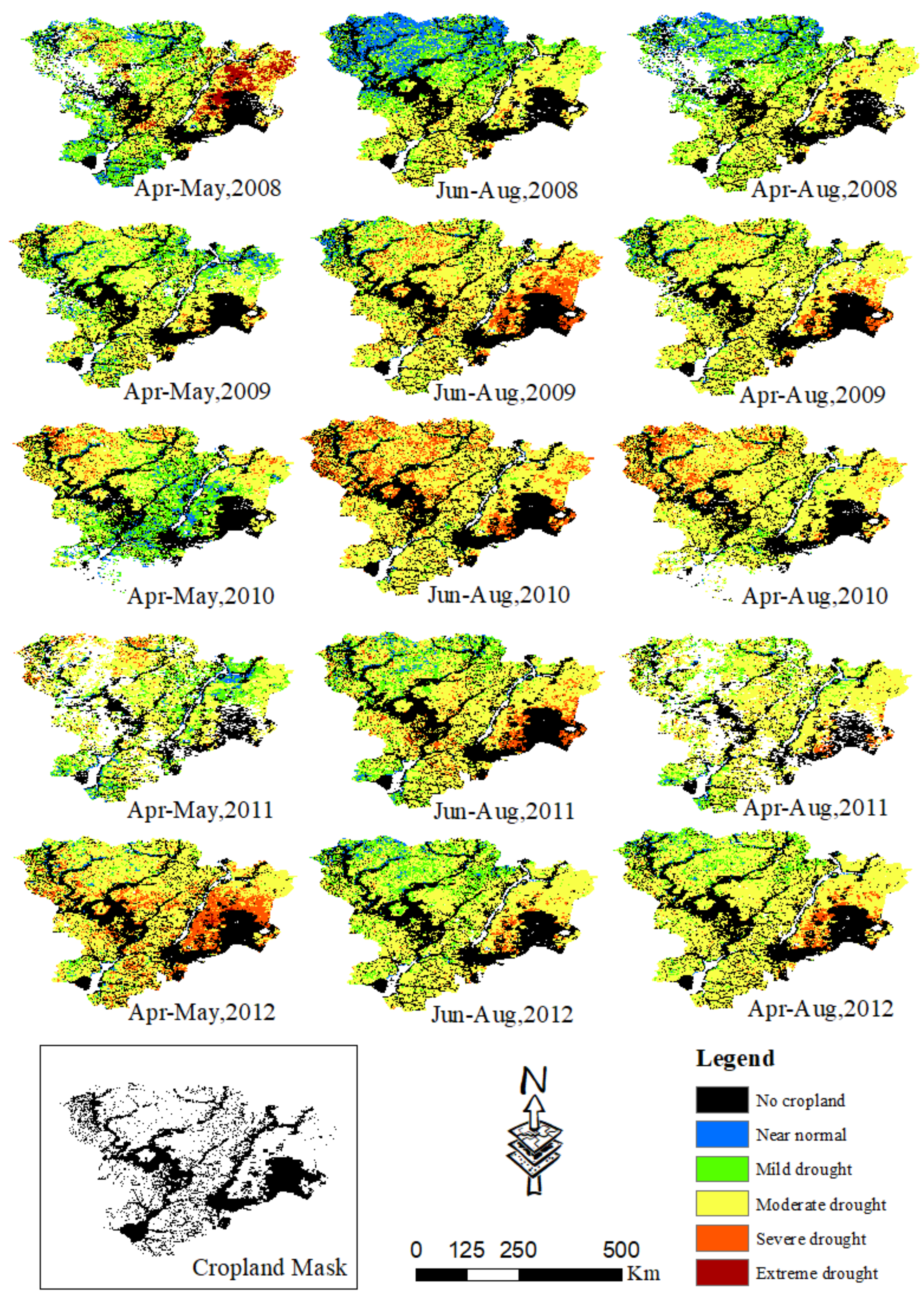
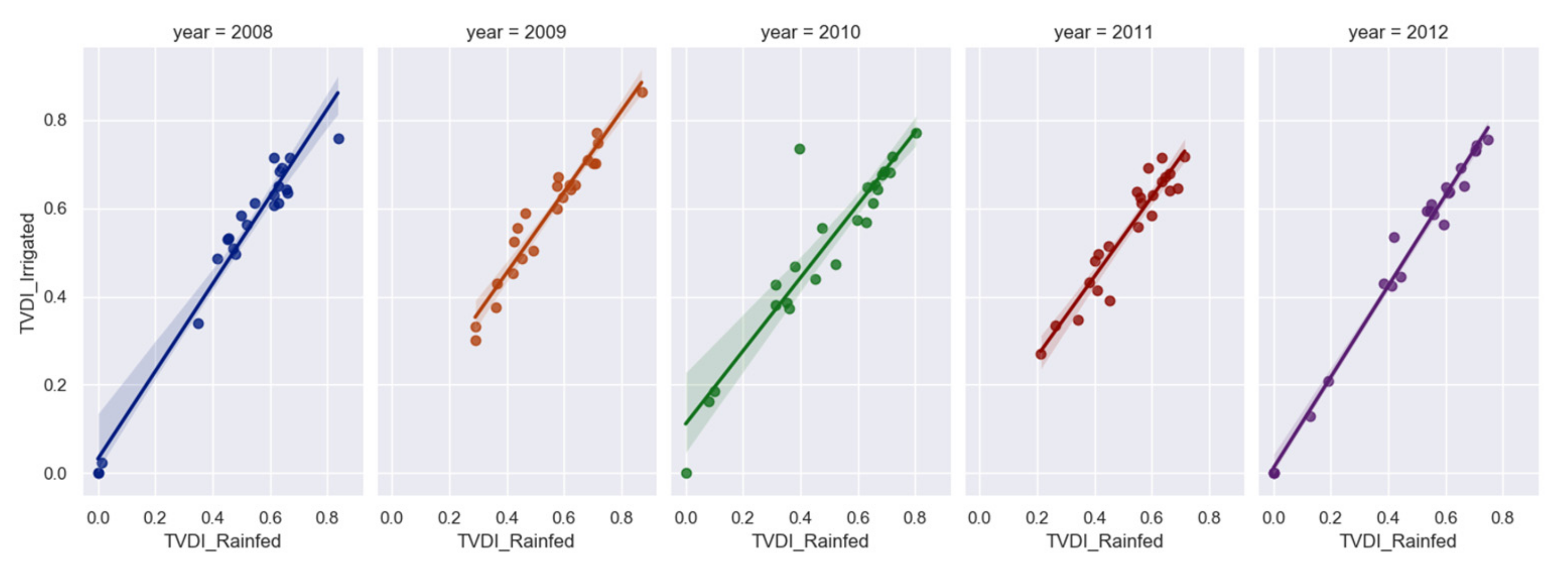
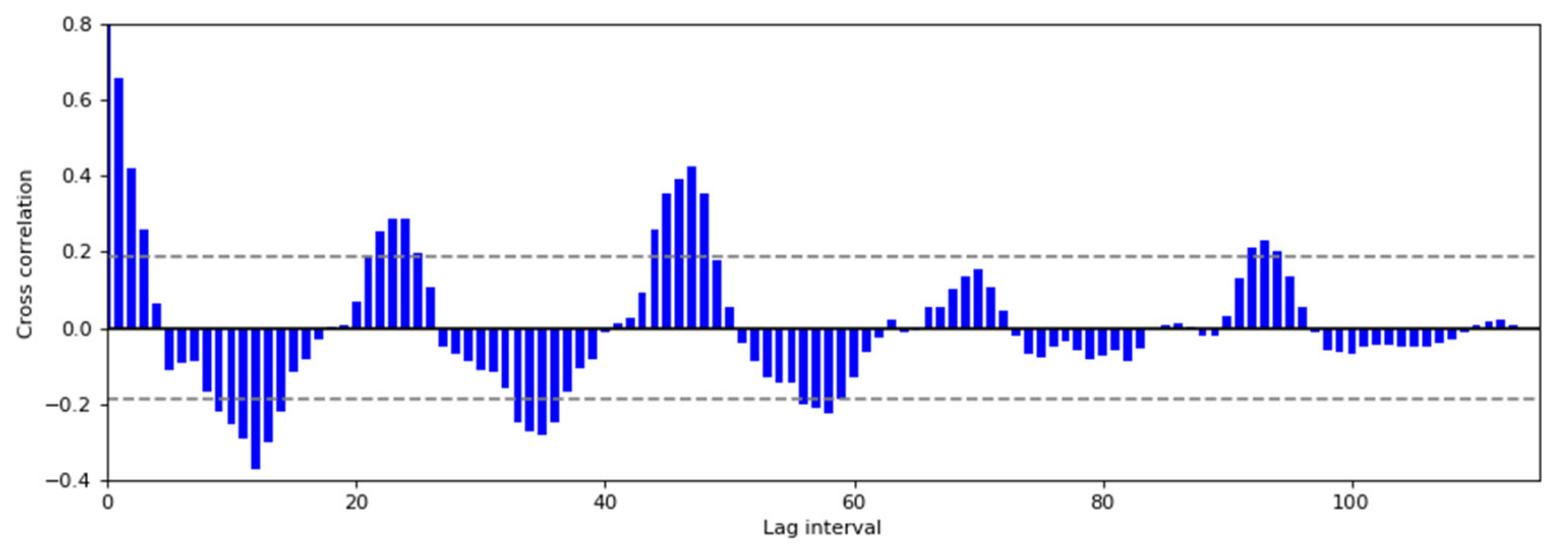
| Data Set | Coverage | Period | Frequency | Resolution |
|---|---|---|---|---|
| MOD13A2 | Global | 2000–present | 16-daily | 1 km × 1 km |
| MOD11A2 | Global | 2000–present | 8-daily | 1 km × 1 km |
| PERSIANN-CDR | 60°S–60°N | 1983–present | Daily | 0.25° × 0.25° |
| Auxiliary Data Set | Coverage | Period | Categories | Resolution |
|---|---|---|---|---|
| GFSAD30 | Cropland extent | 1990–2017 | Five dominant crop types | 1 km × 1 km |
| GlobeLand30-2010 | 80°S–80°N | 2010 | 10 types of surface cover | 30 m × 30 m |
| TVDI | Levels | Soil Moisture Status |
|---|---|---|
| 0 < TVDI < 0.46 | No drought | Surface water is sufficient or normal |
| 0.46 ≤ TVDI < 0.57 | Mild drought | Small amount of surface evaporation and dry air near the surface |
| 0.57 ≤ TVDI < 0.76 | Moderate drought | Soil surface is dry and vegetation leaves are wilting |
| 0.76 ≤ TVDI < 0.86 | Severe drought | Thicker dry soil layers appear, and vegetation is withered |
| 0.86 ≤ TVDI < 1 | Extreme drought | Surface vegetation is dry or dead |
| April to May | May to June | April to August | Levels of Drought Disaster |
|---|---|---|---|
| 0 < CDDI < 0.828 | 0 < CDDI < 1.932 | 0 < CDDI < 2.76 | No drought |
| 0.828 ≤ CDDI < 1.026 | 1.932 ≤ CDDI < 2.394 | 2.76 ≤ CDDI < 3.42 | Mild drought |
| 1.026 ≤ CDDI < 1.368 | 2.394 ≤ CDDI < 3.192 | 3.42 ≤ CDDI < 4.56 | Moderate drought |
| 1.368 ≤ CDDI < 1.548 | 3.192 ≤ CDDI < 3.612 | 4.56 ≤ CDDI < 5.16 | Severe drought |
| 1.548 ≤ CDDI < 1.8 | 3.612 ≤ CDDI < 4.2 | 5.16 ≤ CDDI < 6 | Extreme drought |
| Total State Area (km2) | Affected Area from April to August (km2) | Proportion (%) | Levels of Drought Disaster | Judgment Basis | |
|---|---|---|---|---|---|
| Statistics from CDDI | 108,448 | 35,913 | 33.12% | Non-arable land or no drought | 0 < CDDI < 2.76 |
| 9184 | 8.47% | Mild drought | 2.76 ≤ CDDI < 3.42 | ||
| 59,734 | 55.08% | Moderate drought | 3.42 ≤ CDDI < 4.56 | ||
| 3571 | 3.29% | Severe drought | 4.56 ≤ CDDI < 5.16 | ||
| 46 | 0.04% | Extreme drought | 5.16 ≤ CDDI < 6 | ||
| Statistics from Oxfam Report | 113,900 | 5407.042 | 4.75% | none | Farmer survey |
© 2020 by the authors. Licensee MDPI, Basel, Switzerland. This article is an open access article distributed under the terms and conditions of the Creative Commons Attribution (CC BY) license (http://creativecommons.org/licenses/by/4.0/).
Share and Cite
He, Y.; Chen, F.; Jia, H.; Wang, L.; Bondur, V.G. Different Drought Legacies of Rain-Fed and Irrigated Croplands in a Typical Russian Agricultural Region. Remote Sens. 2020, 12, 1700. https://doi.org/10.3390/rs12111700
He Y, Chen F, Jia H, Wang L, Bondur VG. Different Drought Legacies of Rain-Fed and Irrigated Croplands in a Typical Russian Agricultural Region. Remote Sensing. 2020; 12(11):1700. https://doi.org/10.3390/rs12111700
Chicago/Turabian StyleHe, Yuanhuizi, Fang Chen, Huicong Jia, Lei Wang, and Valery G. Bondur. 2020. "Different Drought Legacies of Rain-Fed and Irrigated Croplands in a Typical Russian Agricultural Region" Remote Sensing 12, no. 11: 1700. https://doi.org/10.3390/rs12111700
APA StyleHe, Y., Chen, F., Jia, H., Wang, L., & Bondur, V. G. (2020). Different Drought Legacies of Rain-Fed and Irrigated Croplands in a Typical Russian Agricultural Region. Remote Sensing, 12(11), 1700. https://doi.org/10.3390/rs12111700







